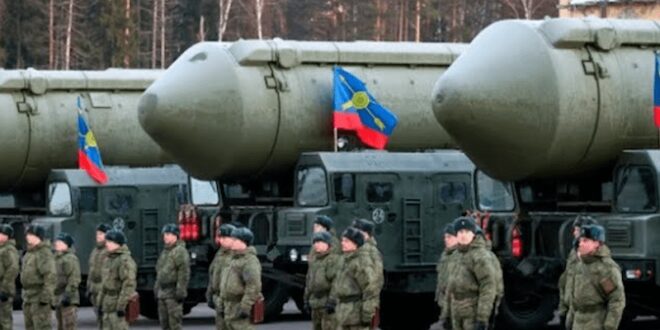On 25 September, in the biannual standing conference on nuclear deterrence in Russia’s Security Council, President Putin proposed changes to the “fundamentals of state policy of the Russian Federation in the sphere of Nuclear deterrence” or Russia’s nuclear doctrine. Along with the nuclear doctrine, the military doctrine was also proposed to be updated. The rationale of this proposed change was due to the new changes in the military-political realm, factoring in new threats emerging for Russia and its allies—i.e., the increasing intensity of the Ukrainian attacks on Russian soil and the recent request of Ukrainian president Volodymyr Zelensky to the United States (US) and the United Kingdom(UK) to strike deep inside Russia using long-range missiles.
Since last year, talks have been held between specialists from the Russian Ministry of Defence, the Ministry of Foreign Affairs, and the Office of the Security Council on making amendments to Russia’s nuclear doctrine. This new doctrine underlines Moscow’s red lines to further limit Ukraine’s options in striking within Russian territory and is a signal to NATO countries to elicit restraint in its support for Ukraine by limiting Kyiv’s counter-attacks within the Ukrainian theatre.
What are the new proposed changes?
The proposed changes will update the 2020 nuclear doctrine and aim to broaden the list of states and alliances against which deterrence can be carried out. The language has evolved wherein a non-nuclear state conducting aggression against Russia with the support of a nuclear state- even using conventional weapons-will be interpreted as a joint attack against Russia. Second, it has reduced the threshold for military attacks inside Russia.
The launch of conventional weapons such as hypersonic missiles, drones, strategic and tactical aircraft, and cruise missiles towards the Russian border and crossing into the territory of the Russian Federation is justification for the use of nuclear missiles. Thirdly, while the previous doctrines mentioned Russia calling for nuclear deterrence in defence of an ally, the proposed doctrine calls for a nuclear response in the event of an attack against Belarus, citing Minsk as a party to the treaty establishing the Union State of Russia and Belarus. Further, Putin emphasised the importance of the nuclear triad for the guarantee of Russia’s survival and as an instrument for maintaining the balance in the world.
A nuclear doctrine befitting the present geopolitics
The language of Russian nuclear doctrines normally is directly proportional to the geopolitical configuration of the world order, vis-à-vis the geopolitical aspirations of Russia. Since 2010; the language employed has become more offensive in nature. Putin justifies it by citing the nuclear doctrines of Western countries, which, in his words-are at war with Russia and have similar, if not more, offensive nuclear doctrines than Russia.
The 2020 doctrine followed suit, but it had a lot of ambiguity. Sergey Karaganov, Professor Emeritus at the Higher School of Economics Moscow, a prominent voice on nuclear politics in Russia who is an advocate for an offensive nuclear doctrine, opined that past Russian nuclear doctrines are monstrously outdated, including the 2020 nuclear doctrine, which, according to him does not serve the function of effective deterrence, and that the collective West has to operate with the strategic foresight that Russia has nuclear weapons or it can use them (see table 1).
Since the invasion of Ukraine in 2022, the threat of using nuclear weapons by Russia has increased at various stages of the conflict. Despite Russia’s provocations of using nuclear weapons, the West continues to supply Ukraine with long-range weapons and ballistic missiles, undermining Moscow’s red lines. Since early this year, Ukraine’s drone attacks have targeted energy installations in Russia. In May 2024, Ukrainian drones attacked two early warning radar stations, which were installed to spot incoming nuclear weapons launched from the West.
Further, in August, Ukraine launched an incursion in Kursk; almost a month later, Russia began its counter-offensive in Kursk. Now, with options being limited for Ukraine, Zelensky appealed to the UK and the US for permission to use long-range weapons to strike deep inside Russian cities. Seeing discussions being held in the West on granting permission for the same, Russia’s Press Secretary, Dimitry Peskov, later stated that the proposed changes must be considered a specific signal, warning of the consequences of participating in an attack against Russia.
Table 1: Situations under which nuclear weapons will be used against an adversary
| 2020 Nuclear doctrine | Proposed 2024 Nuclear doctrine | |
| Situations under which Nuclear weapons will be deployed | a) The receipt of reliable information about the launch of ballistic missiles attacking the territories of the Russian Federation and (or) its allies b) By the enemy’s use of nuclear weapons and weapons of mass destruction against Russia (or) its allies c) Aggression against the Russian Federation using conventional weapons when the very existence of the state is at risk. d) the enemy’s attacks on critically important state or military facilities of the Russian Federation, which will lead to the disruption of the response actions of nuclear forces; | a) Aggression by a non-nuclear state in support of a nuclear state is to be considered a joint attack on the Russian Federation b) By the massive launch of cruise missiles, drones, hypersonic and other aircraft crossing into the border of the Russian Federation c) Critical threat to Russia’s sovereignty even with conventional weapons d) Aggression against Belarus |
No radical changes
Despite the hype, the proposed changes are not a radical departure from the previous nuclear doctrines. The prevailing nuclear doctrine allows for the use of nuclear weapons in response to conventional attacks executed on Russian soil, but the new proposed doctrine aims to further clarify the terms of use.
For instance, the extension of the Kremlin’s nuclear umbrella to Belarus is not a move driven by symbolistic virtues; one of the biggest reasons for the inclusion is that the 2020 doctrine stipulated that an attack against a Russian ally would be grounds for nuclear retaliation, which in the present geopolitical scenario has a radically different meaning. Russia’s increasing bonhomie with North Korea maturing into a friendship treaty in June this year would imply Russia would include North Korea in its nuclear umbrella.
And even though Moscow is increasingly being isolated by the collective West, it understands the complexity of dealing with North Korea. Moscow has thus employed a language which reflects that Russia’s nuclear escalation has little to no implications for the geopolitics of North East Asia. Hence, while there is an element of escalation, the core structure of the nuclear doctrine remains unchanged.
International response
Washington was cautious in its approach to give assent to Ukraine to use long-range weapons even before Putin officially proposed changes to the present doctrine, as there was credible intelligence of a lethal response from Moscow if Ukraine allowed to strike deep into Russia. The US Secretary of State Antony Blinken called the move irresponsible. Further, a day after Putin proposed changes, on 26 September, the US announced the sending of glide bombs with ranges of 20 km to 130 km to Ukraine. However, there was no mention of permitting Ukraine to strike deep into Russia. The EU foreign service spokesperson Peter Stano re-emphasised that the EU policy of supporting Ukraine will not change because of Putin’s announcement.
As Russia moves towards the drafting of its 2024 nuclear doctrine, it appears that Ukraine’s ambitions to strike deep into Russia have reached an impasse, limiting its options on the battlefield. Moscow’s strategic response seems to have been effective; it has redefined its red lines and likely mitigated the risk of future surprises. Any significant shifts in the current situation now seem dependent on the outcome of the upcoming US presidential elections.
 Eurasia Press & News
Eurasia Press & News




